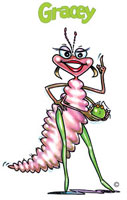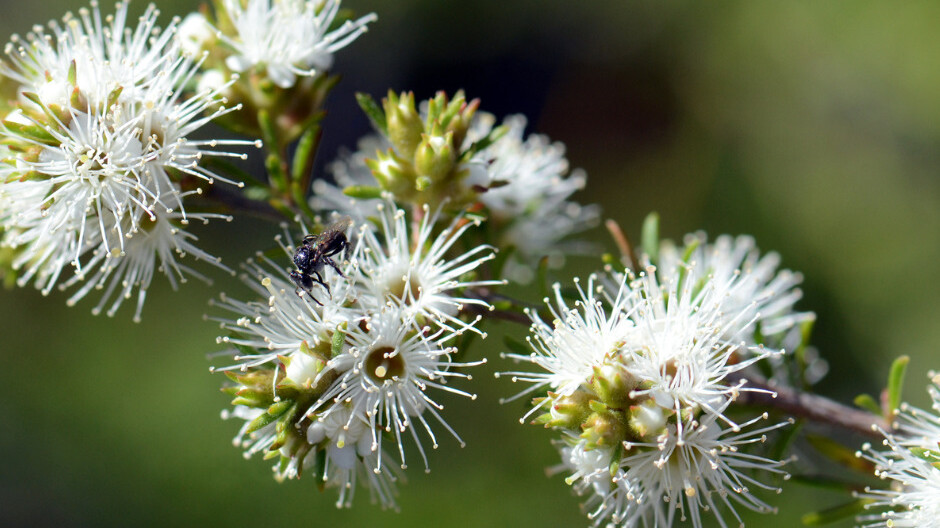There are plenty of garden critters that are useful predators of plant pests, and SGA encourages home gardeners to reduce their chemical use, in order to encourage predator activity.
Many companies supply a range of garden predators for sale to commercial, home and community gardeners. We just can’t resist introducing the ‘characters’, known as Backyard Buddies ™, introduced by Organic Crop Protectants, since we think the company has done a splendid job of developing their respective stories (plus it’s a great initiative)! You will need to contact the company for further information and costs, www.ecoorganicgarden.com.au

Gracey – the Green Lacewing
Hello my name is Gracey. You would better know me as an iridescent green glassy-winged insect that lays her eggs on long slender white stalks all over the garden. That’s what I look like as an adult! You very rarely see me in this form because I like to carry my snack wrappers on my back as fashion accessories. My favourite home is amongst veggies, roses, or any other part of the garden where I can find my favourite snacks which are aphids, mites, juvenile whitefly, small caterpillars and moth eggs. I will also eat mealy bug if they are the only food you have in your garden. Like my Buddies, I am delivered to you in a small plastic container. I come as an egg with 99 of my sisters, packed in Lucerne chaff. Sprinkle the chaff equally into small shallow cardboard containers or my very own release boxes and hang them close to my favourite food so that when I hatch I can start eating straight away.

Pete – the Predatory Mite
G’day my name is Pete. I am very busy and always hungry because I have eight legs to feed. You probably never ever see me because I am very small but I do a big job in your backyard. My favourite food is Two Spotted Mite (TSM, also called Red Spotted Mite). TSMs are those pesky blighters that suck all the nutrients out of foliage and cause russetting and yellowing of your precious rose leaves, tomato leaves and many other plants. I am delivered to you in a small plastic container with 999 of my mates on 20 to 30 bean leaves. Place one bean leaf into each plant where TSM like to live. If TSM are a big problem (webbing under the leaves), place 2-3 bean leaves into each plant.

Linda – Cryptolaemus Ladybeetle
Hi, my name is Linda and I’m your best friend if you have plants that suffer from mealybug attack. My little baby sisters and I love to eat mealybugs, they are like little balls of white fairy floss. I also like to eat Pulvinaria scales such as cottony scale in citrus and other soft scales. Since my brother Luke also likes scale I leave them for him to eat if there are enough mealybugs around. I am delivered to you in a small plastic container with 39 of my sisters. We rapidly go to work finding mealybugs to eat and lay our eggs into mealybug egg masses. Our babies hatch 2-3 weeks later and are sometimes confused with mealybugs because they look similar, like little white balls of fluff; but they move much faster on plants. Tap 1-2 of my sisters out of the plastic container close to a mealybug infestation. My sisters and I will feed on up to 40m2 of garden infested with mealybugs.

Luke – Chilocorus Ladybeetle
G’day my name is Luke, and I love to eat scale. Scale are like little mini pizzas to me and I enjoy an assortment of flavours including Red Scale, Oriental Scale, Oleander Scale and White Louse Scale (Citrus Snow Scale). Just like my sister Linda, I have baby brothers who also feed on scale and look very different to me. In fact they look like little brown porcupines. You will see them about 1 week after you release me into the garden. I am delivered to you in a small plastic container with 29 of my brothers and we rapidly go to work finding scale to eat. Tap one or two of us out of the plastic container close to a scale infestation. My brothers and I will feed on 20-40m2 of garden infested with scale.

Walter – Parasitic Wasp
Greetings, my name is Walter and my job is a little different from the other Backyard Buddies. In a lot of ways, my job is the most important because I help protect the rest of my Buddies from deadly fly spray, which can kill us all. I have the very specialised task of controlling house flies, stable/horse flies and buffalo flies by zeroing in on fly larvae. It’s a dirty job but I am well-trained in this area. Once I find fly larvae, I deposit some eggs, which soon hatch out and use the fly larvae as baby food to grow and develop. In doing so, we control flies before they become adults. To achieve this goal, we need to be released in areas where flies breed, starting in spring or early summer. Follow-up releases are required every fortnight during the fly season. I come in a special cocoon of fly pupae mixed in vermiculite with about 2500 of my brothers and sisters. If you have horses or cows, you should release a minimum of 100 and a maximum of 500 of us per animal per fortnight. For smaller animals like chooks, cats and dogs you need between 5 and 50 of us to be released every fortnight.
Banner image: Jason Hollinger – Lady BugUploaded by Amada44, CC BY 2.0, https://commons.wikimedia.org/w/index.php?curid=24213810
Related Articles:
Wildflower gardens – What’s the buzz about?
In the quest for sustainable and environmentally conscious practices, gardening enthusiasts and nature lovers alike are turning to a time-tested…
The Importance of building soil health for a biodeverse, productive garden
Creating a thriving garden that not only sustains itself but also contributes to the broader ecosystem requires more than just sunlight and water.…




